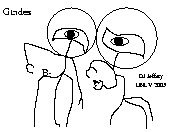Textbooks:
Griffiths and Greene.
Griffiths is the official textbook for the lecture material.
I expect many students have a copy already earlier courses. If so good.
But if not and you have a more-or-less equivalent textbook that will work just as well.
So don't buy Griffiths, unless you are sure you need to.
Everyone agrees Griffiths a pretty darn good intro quantum mechanics textbook.
I've not looked at infinitely many intro quantum mechanics textbooks, but this is the best I've seen.
But familiarity breeds quibbles, and so there will be a lot of deviations and additions in my lectures.
But if you knew everything in Griffiths, you would know a whole lot
about intro quantum mechanics (QM)
Brian Greene, 2004, The Fabric of the Cosmos is the 2nd textbook.
It is purely for reading, I will NOT lecture on it.
But the readings are reported for marks. So you really, really do need a copy. See below.
Greene is pretty cheap: $ll or so new.
Nature of the Course:
This is a course of intro quantum mechanics (QM).
At this level, quantum mechanics is rather abstract and idealized.
How you get from this level to modern real world results is a long journey
yours truly as never followed.
It's no surprise to you that this is a pretty hard course.
But as I always say, it's nothing like
organic chemistry.
You really need to put in at least 2 hours out of class for every hour in class.
The two-hour rule is true for almost all courses actually.
This course will be run in a somewhat active mode.
The instructor is trying to get beyond just passive learning---which
is rather inefficient learning.
There will be a question break: see below.
Also since the students will have required
daily note readings, they should be prepared every day
to think and discuss the topics.
In order to do science, you have to think and talk science.
Exams:
There will be 2 (or less likely 3)
in-class exams and a 2-hour COMPREHENSIVE FINAL.
The in-class exams cover the material up to some cut-off point
that will be announced in class and
below on schedules for
Semester 1
and
Semester 2.
The final is about 50 % weighted or more on material since the last in-class
exam and about 50 % weighted or less on all the material that came before
the last in-class exam.
The last material may receive less weighting on the final if the
time from the last in-class exam is short.
Nosta bene:
Even though exams are formally restricted to set exam
topics, intro QM
is intrinsically cumulative
and
earlier topics are assumed known insofar as they are needed for the exam topics.
Earlier topics include those from Semester 1 if we are
in Semester 2.
TENTATIVE EXAM SCHEDULE
_________________________________________________________________
Exam Date Solutions (posted post-exam)
_________________________________________________________________
Exam 1 Mar09 W Exam 1 solutions
Exam 2 Apr15 F Exam 2 solutions
Exam 3 Apr29 F Exam 3 solutions May be omitted.
Final Exam May11 W Final Exam solutions
The final is 7:30--9:30 am in the regular class room
as specified by Finals Schedule for 2011 Spring.
_________________________________________________________________
The in-class exams will consist of maybe 10--20 multiple-choice questions
and a few full-answer questions.
The multiple-choice questions are NOT intended to be
hard or tricky; they are intended as a warm-up.
The final exam will be somewhat like the in-class exams, but about twice as long.
The exams are closed book.
Calculators are permitted for calculational work only.
No stored constants, solutions, or formulae.
No using algebra or calculus solvers.
No use of programmable features.
Cell phones MUST be turned off and be out of sight.
An equation sheet will be provided with the exams.
This is the same equation sheet that comes with the homeworks.
There are NO scheduled review days.
But students can keep the instructor busy answering questions
on the day before exams.
Make-up exams are possible, but students must ask for them
promptly and avoid knowing anything about given exams.
Evaluation and Grading:
The grading categories, their weightings, and their drops are:
homeworks 10 % or less 1 drop
note readings 10 % or less 3 drops
G & A readings 10 % or less no drops
2 or 3 in-class exams 35 % or more no drop
1 comprehensive final 35 % or more no drop
Each in-class exam is worth 17.5 % or 11.67 % of final grade.
Attendance is NOT kept and NO marks are assigned for attendance.
Daily note readings can be reported without attending.
Students are encouraged to keep good attendance.
There are absolutely NO extra credits.
Letter grades will be assigned
per
NAU
grading policy--which allow instructors some freedom of
interpretation on how do determine ``average''.
The instructor uses a curve to automatically
assign letter grades during the semester---if there are enough
students to make a curve meaningful---if there arn't the instructor
just decides on letter grades.
There is NO fixed scale.
The final grades are decided on by the instructor directly---the curve
is NOT used, except as a guide.
Students can always ask the instructor for their current
mark record and letter grades.
But this cannot be done over the phone.
I can email a response by GPS.
The instructor will submit MIDTERM GRADES (for lower level courses) and FINAL GRADES
as scheduled in the
academic calendar---which
doesn't specify any midterm grade dates for summer courses.
This semester, I will be submitting grades sometime on or before May19 as per
Spring 2011 Grading Schedule".
Remember that after an instructor has submitted FINAL GRADES,
any adjustments (except for purely clerical errors) are
NOT allowed by university policy.
See
Policy on Grades from the
UI Catalog.
Note that E-6 states that grade changes after instructor submission are
only allowed for clerical corrections, not for reweighting or additional work.
There is another avenue for grade emendation:
the Academic
Hearing Board (1640.02 C-4) can have a say on grades---but it's not
very promising.


